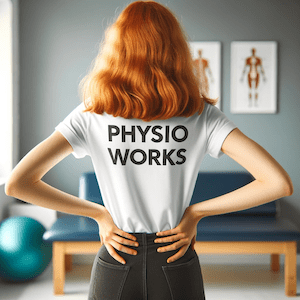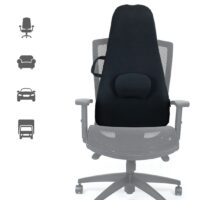Core Stability Training
Article by John Miller


Core Stability Training
The Key to Enhancing Your Back Stability Score and Achieving Low Back Pain Relief
Function Core Training
In recent years, core stability training has become a fundamental aspect of physiotherapy, particularly for individuals suffering from low back pain. As physiotherapists, we see firsthand how functional core retraining can significantly impact a person’s quality of life.
This article aims to educate you on core stability and its benefits, including an innovative approach like the Ultrasound-Guided Exercise Program.
The Importance of Core Stability Training
Core stability refers to the ability of your muscles to support your spine and pelvis. It’s crucial for maintaining balance, ensuring proper posture, and preventing injuries. In physiotherapy, we often see clients with low back pain who have weak core muscles. Strengthening these muscles is not just about getting a toned abdomen; it’s about creating a solid foundation for your entire body.

Research Insights
Recent studies have shown that core stability training can significantly reduce low back pain. A 2023 study in the “Journal of Physiotherapy” revealed that patients who engaged in core strengthening exercises experienced a notable decrease in pain and improvement in their quality of life. This score measures the resilience of your back under various conditions.
Functional Core Retraining: Beyond Traditional Exercises
Traditional core exercises focus on static movements like planks or crunches. However, functional core retraining takes a more holistic approach. It involves exercises that mimic everyday activities, ensuring that the strength you build is practical and beneficial in real-life scenarios.
Ultrasound-Guided Exercise Program
A groundbreaking approach in core training is the Ultrasound-Guided Exercise Program. This technique uses ultrasound imaging to give real-time feedback on how your muscles are working during exercises. It has proven especially effective for patients who struggle to engage their core muscles correctly.
Addressing Low Back Pain Relief
Low back pain can be debilitating, affecting every aspect of your life. Core stability training plays a crucial role in alleviating this pain. By strengthening the core, you’re essentially giving your back the support it needs to function without discomfort.
Tailored Exercise Regimens
As physiotherapists, we understand that every individual is unique. Therefore, we design exercise programs tailored to your specific needs and pain levels. Whether you’re an athlete or someone who spends long hours at a desk, there’s a core stability program for you.
Your Journey to a Stronger Back
Embarking on a core stability training program is a journey. It’s not just about relieving pain; it’s about building a stronger, more resilient body. Your physiotherapist will guide you through this process, ensuring that you’re performing exercises correctly and safely.
Progress Monitoring
Using tools like the Back Stability Score (BSS), we can monitor your progress. This score is a great motivator, showing you how far you’ve come since starting your core training.
Conclusion
Core stability training, particularly through functional core retraining, offers a promising path to low back pain relief. With innovative approaches like the Ultrasound-Guided Exercise Program, achieving a strong, pain-free back is more attainable than ever.
Your Next Step
If you’re struggling with low back pain, or just want to improve your overall physical health, consult with a physiotherapist. Together, we can develop a plan that’s right for you, guiding you towards a stronger, more stable core and a healthier life.
Related Articles
Rochedale - Call 38410277
Book Online: RochedaleSalisbury - Call 32751044
Book Online: SalisburySandgate - Call 32691122
Book Online: SandgateArticle by John Miller
Do Core Exercises Alleviate Lower Back Pain?
Lower back pain affects millions worldwide, and recent research highlights the significance of core exercises in managing this common ailment. Let's explore how core stability training can be a game changer.


What's Your Core Stability?
Your lower back, a region prone to instability, comprises five vertebrae with remarkable flexibility but limited bone support. The deep core muscles are pivotal in supporting and manoeuvring your lower back and pelvis. They're designed for round-the-clock operation, ensuring spinal stability.
The Link Between Core Muscles and Back Pain
Research reveals a direct link between back pain and impaired core muscle functionality. The Transversus Abdominis (TA), a key muscle, often shuts down with lower back pain. This shutdown is universal among sufferers. Alarmingly, the TA doesn't automatically reactivate post-recovery, increasing vulnerability to further injuries.
Read more: Deep Core Stability Muscles
Why Core Stability Matters
Activating and strengthening your core muscles offers more than just back support. It enhances overall athletic performance, including speed, agility, and strength. Core stability exercises are pivotal in not only preventing but also diminishing existing back pain.
Seeking Professional Advice
If you're experiencing lower back pain, consulting a physiotherapist is crucial. They can guide you through tailored exercises, ensuring you engage the right muscles effectively. Visit PhysioWorks for more information and resources.
Conclusion
Incorporating core stability exercises into your routine can significantly impact your lower back health. Remember, prevention is better than cure, and your physiotherapist can guide you on this journey.
What to Do?
Contact your local PhysioWorks physiotherapist for a personalised core stability programme. They can offer professional advice and support tailored to your needs.
Related Articles
Rochedale - Call 38410277
Book Online: RochedaleSalisbury - Call 32751044
Book Online: SalisburySandgate - Call 32691122
Book Online: SandgateWhat Causes Lower Back Pain?
Introduction
Lower back pain is a widespread issue in Australia, stemming from diverse conditions. As physiotherapists, we often encounter various causes of this pain. This guide aims to shed light on these causes and provide valuable insights for effective management.


Muscle-Related Injuries
Muscle injuries are a predominant cause of lower back pain, including:
- Back Cramps and Muscle Pain: Typically resulting from overuse or strain.
- Core Stability Deficiency: Weak core muscles can lead to increased back strain.
- DOMS (Delayed Onset Muscle Soreness): Soreness affecting back muscles post-exercise.
Recent research underscores the importance of regular exercise and core strengthening in preventing these injuries.
Bone-Related Injuries
Bone health is crucial in lower back pain, encompassing conditions like:
- Spondylosis: Degenerative spine conditions.
- Spondylolysis or Stress Fracture: Common in athletes, such as cricket bowlers.
- Spondylolisthesis: Occurs when a vertebra slips over another.
- Osteoporosis: Causes bones to weaken, increasing fracture risk. Advancements in bone density scanning have improved early detection and management.
- Scheuermann’s Disease: Affects spinal bone growth in teenagers.
- Scoliosis: An abnormal curvature of the spine causing pain.
- Spinal Stenosis: A narrowing of the spinal canal leading to nerve compression.
Disc-Related Injuries
Spinal discs are vital for spinal health:
- Bulging and Disc Protrusions: These discs protrude or "slip" and can press on nerves.
- Herniated Disc: A more severe form of disc protrusion.
- Degenerative Disc Disease: Age-related disc wear and tear.
Minimally invasive surgical techniques have transformed the treatment of severe disc-related injuries where physiotherapy and other non-operative options fail to improve.
Back Joint Injuries
- Facet Joint Pain: Arises from arthritis or stress on these spinal joints.
Nerve-Related Injuries
Nerve issues can lead to:
- Nerve Pain and Pinched Nerves: Caused by spinal nerve compression from disc bulging or arthritic changes.
- Sciatica: Irritation of the sciatic nerve.
Physiotherapy and newer medications have been effective in managing these conditions. Some will require injection therapies or surgery.
Pelvis-Related Injuries
Pelvic issues also contribute to lower back pain:
- Sacroiliac Joint Pain: Involving joints connecting the spine to the pelvis.
- Piriformis Syndrome: Where the piriformis muscle irritates the sciatic nerve.
Pregnancy-Related Pain
- Pregnancy Back Pain: Often due to increased back strain during pregnancy. Prenatal physiotherapy programs are beneficial.
Systemic Diseases
Systemic diseases like Ankylosing Spondylitis, Fibromyalgia and Rheumatoid Arthritis can cause back pain.
Recent Research and Advancements
Current research emphasises a holistic approach to treating lower back pain. Techniques like yoga and Pilates, alongside traditional physiotherapy, and conservatively progressed gym programs show significant relief. The role of diet in managing weight and inflammation is increasingly recognised.
Best Treatments for Lower Back Pain
Treatment varies but often includes:
- Physiotherapy
- Pain management
- Strength and flexibility exercise programs
- Ergonomic adjustments
- Surgical interventions for severe cases
Conclusion
Lower back pain is a significant health concern in Australia. Understanding its causes and seeking professional physiotherapy advice can greatly improve life quality. Remember, early intervention is key for an effective recovery.
What to Do?
If you're experiencing lower back pain, it's vital to consult a physiotherapist or doctor. They can provide an assessment and customised treatment plan based on your specific condition.
































































